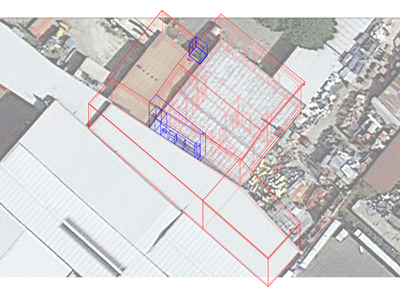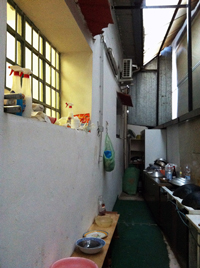You are in: Home page > Magazine Archive > Factory/City
Prato, Italy. Down a quiet street in the ‘macrolotto 0’ industrial zone, cardboard, paper, and squares of textile patch the broken windows of dilapidated factories. The street is empty, save for the odd white van idling by the curb. But far from deserted, the street is veritably humming with life. From every wall and window emanates the unmistakable staccato of sewing machines.
The street continues past empty lots thick with weeds, then a set of apartment towers, their chipped stones wet with rain and their balconies hung with laundry. A few faces appear above; a man smoking a cigarette, a curious child, trailed by the scolds of a waiting mother.
Then the street skirts a field totally reclaimed by nature, save for a cluster of fig trees growing in a meticulously trimmed patch of grass. In the distance are the silver barrelled roofs of the historic città fabbrica, or factory city. On the left are the low brick buildings of a school campus. Their facades punched with geometric shapes have a noble appearance, abiding a model of architectural Suprematism popular in the 1960s, yet these buildings were completed only in the last decade. At the edge of campus, a wide road appears with cars zipping steadily past. Near the mobile phone shop and the ice cream parlour, stands the Chinese woman with a fanny pack, who sells her body for money and lives alone on the piazza.
Prato is a study of collateral growth in the industry of textiles, coming to bear on an architectural condition. In the years after World War II, the Pratese developed methods of specialisation in parallel to the mass production model of their competitors in Japan and Eastern Europe. They dissolved their large integrated mills in favour of small subcontracted firms, which focused on technologies instead of trends. By the 1980s, Prato’s cottage industry demonstrated a viable manufacturing model, whose banks, unions and industrial associations fell in place to further increase the flexibility of links between firms1. The current of Chinese immigration began in the 1980s as well. From subcontract labor in textiles, the Chinese developed a subsidiary garment industry centered on the pronto moda. Pronto modas are final firms, usually of ten employees or less, that design, cut and market finished garments, all bearing the ‘Made in Italy’ label. The success of the prontisti lies in their opportunism—they import lower quality fabric from China, produce garments off the regulated Italian fashion calendar, and exploit local Chinese labor2. Their business continues to expand into secondary processes such as fabric dyeing and printing, even as Italian-led textile manufacturing rapidly contracts.
The physical disaggregation of the city reflects this dispersive model of collective specialisation. La città fabbrica designates a mix of living, work and civic spaces whose common modifier is the family-led subcontract firm. The relationship of family and labor in the postwar era evolved a unique factory typology in Prato, in which factory shed and family home share a common courtyard3. A map of the industrial district next to the Bisenzio River shows the città fabbrica condition as it existed in the 1990s (Image 1). The city grid is a patchwork of industrial buildings of various sizes, fulfilling all steps of the weaving process. Blocks are split and mingled with smaller scale residential buildings as well as apartments, with ample swatches of communal and commercial space. In a city where labor rather than leisure defined the pursuit of identity, the mastery of space is incomplete. Yet the authority of capitalist accumulation drove the composition of the city. That Chinese workers perform piecemeal work over long hours with their children in the same cluttered space, can be viewed as an exacerbation of a familiar condition. More worrisome is the state of factories in which the Chinese labor and live. A fatal fire in December 2013 revealed the lack of oversight in worker and building safety among the city’s pronto moda. Possible exits were blocked with piles of flammable fabric while workers slept in tiny rooms on the mezzanine level. The Chinese factory supervisors, who slept in a room by the front door, were able to escape. The Italian brothers who owed the building and rented and maintained the space are on trial4.
What is revelatory is the difficulty in assigning blame. Propelled by right wing political campaigns, Italians have defined the failures of their own economy by the successes of Chinese business in broad xenophobic strokes. They accuse the Chinese of stealing their jobs, though the pronto moda remain a distinct industry from Italian textiles, and textiles globally have succumbed to the forces of mass production. They point out the exploitation of labor and abuses of power by Chinese business owners, though similar grievances have arisen against Italian business owners. They attribute the physical degradation of their city to Chinese presence, though Italian property owners continue to rent their insalubrious spaces while turning a blind eye to their use. Despite the collusion of cultural forces, the result of this polarisation is increasing invisibility for the Chinese. In its most insidious form, labor subsumes the life of the worker, who does not occupy discrete physical space throughout his day, but lives and dies in the shadow of his work.
But consider this alternative, where Prato’s collateral industry demonstrates its authority. On a recent visit, I was led down a quiet road into a factory courtyard lined with an array of single story buildings. Some were shuttered and appeared abandoned, but others were in use. The door of one led to a room with rows of sewing machines and cutting tables. From a shed not much bigger than a bathtub, a woman emerged carrying plates of hot food, which she brought into the workshop. The door to the adjoining building was marked with a red cross; inside, the space had been subdivided into one large sanctuary and a series of smaller fellowship rooms. Passing through, I came upon a sliver of a kitchen, not much wider than a grown man’s wingspan, wedged between two exterior walls and roofed with plastic siding. Women stood along a single row of burners, preparing food for the congregation. (Images 2-6)
I was informed that the building was rented, not owned, and converted into a church. The walls were crudely plastered and the rooms unheated. The narrowness of the kitchen posed a violation of safety standards, but technically it was outside. Its position between two buildings reflects the last gesture in a causal sequence of illegal conversion, but also poses the inflection for leisure, or repose, in a place of labor. The hum of sewing machines in the surrounding walls activates the kitchen, and the church it serves. If factories in Prato run seven days a week, the ubiquity of uncommon spaces reclaimed from the existing grid might indicate that work is not as seamless as we fear.
During the same visit, a representative from the centro di commercio shared with me her hopes for the ailing Italian textile industry, and for its xenophobia as well. In her vision, global fast fashion giants such as Inditex and H&M would not only drive textile firms toward utilitarian fabrics but also harness pronto moda production capabilities, uniting Prato’s disparate industries and expanding the scale of its manufacturing5. If this form of investment is to reward local innovation and entrepreneurship, it should rely on subcontract labor and small batch production to feed a centralised supply chain. That is, the physical transformation of space must not be grandiose or utopic, but minor, or invisible. If the factory-converted church and its kitchen are to function as embodied knowledge and resources for building, then the conditions for their construction must be nurtured as well. Indeed it was the same conditions of collective specialisation that engendered the classic città fabbrica grid. Thus the tragedy of globalisation can be acknowledged and exacerbated through a diasporic negotiation of identity.
[1] Michael J. Piore and Charles F. Sabel, The Second Industrial Divide: Possibilities for Prosperity. New York: Basic Books Inc, 1984, pp. 213-16, 226-29.
[2] Antonella Ceccagno, “Chinese Migrants as Apparel Manufacturers in an Era of Perishable Global Fashion: New Fashion Scenarios in Prato,” Living Outside the Walls: The Chinese in Prato, ed. by Graeme Johanson, Russell Smyth and Rebecca French. Newcastle upon Tyne: Cambridge Scholars Publishing, 2009, 42-74.
[3] Bernardo Secchi first used the term mixitè to describe the public and private, production and residential spaces that constitute Prato’s plan. His account, with detailed plans and diagrams, was published as, Un progetto per Prato: Il nuovo piano regolatore (Firenze: Alinea Editrice, 1970).
[4] Marco Imarisio, «Fai sparire tutti i macchinari» I due italiani del rogo di Prato, Corriere della Serra, 21 marzo 2014, pagina 21. Erika Kinetz, “Fire Exposes Illegal Chinese Factories in Italy,” www.bigstory.ap.org, October 20, 2014.
[5] Representative wishes to remain anonymous due to speculative nature of comments. Interview took place on May 22, 2014 at the centro di commercio, Prato, Italy.
















